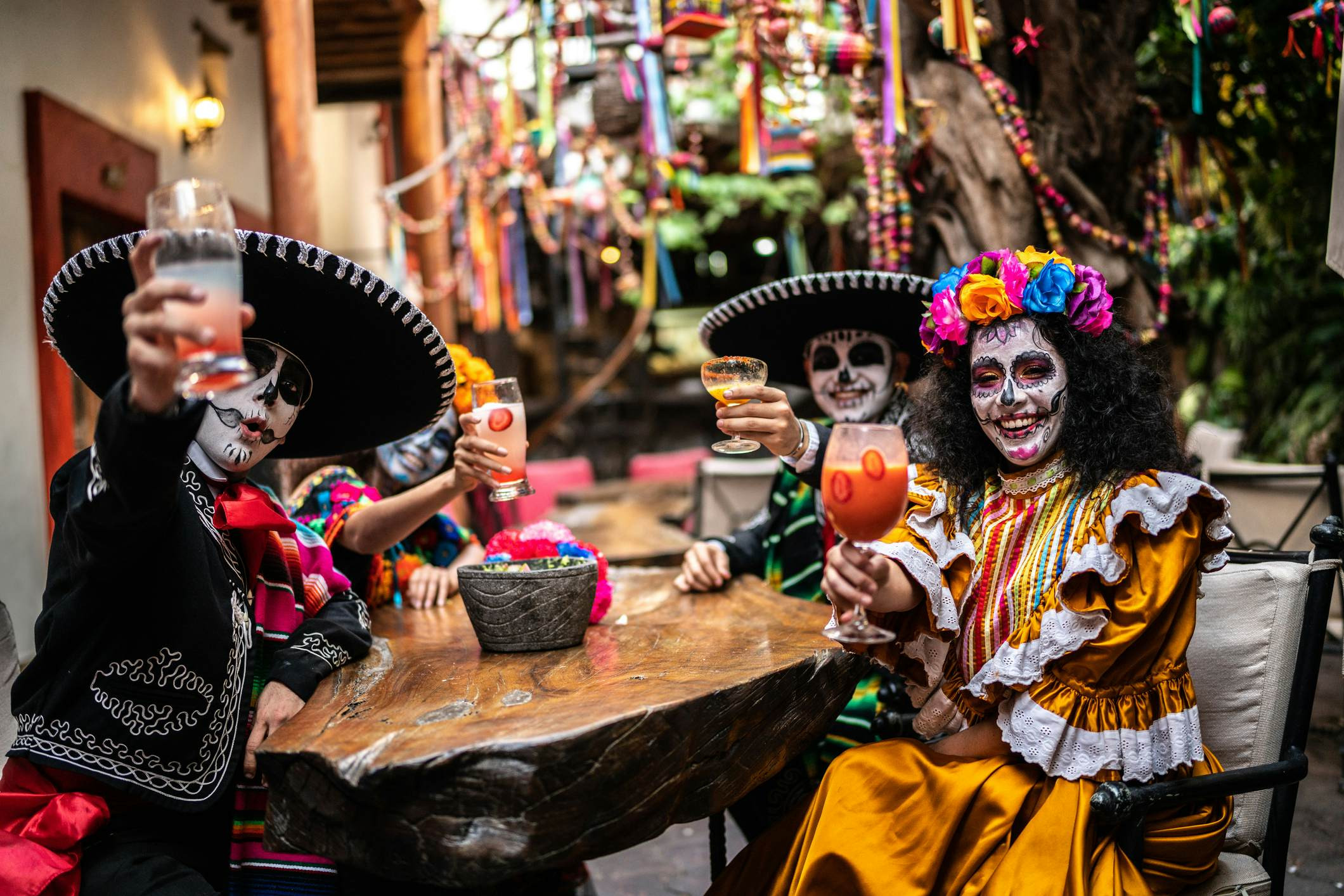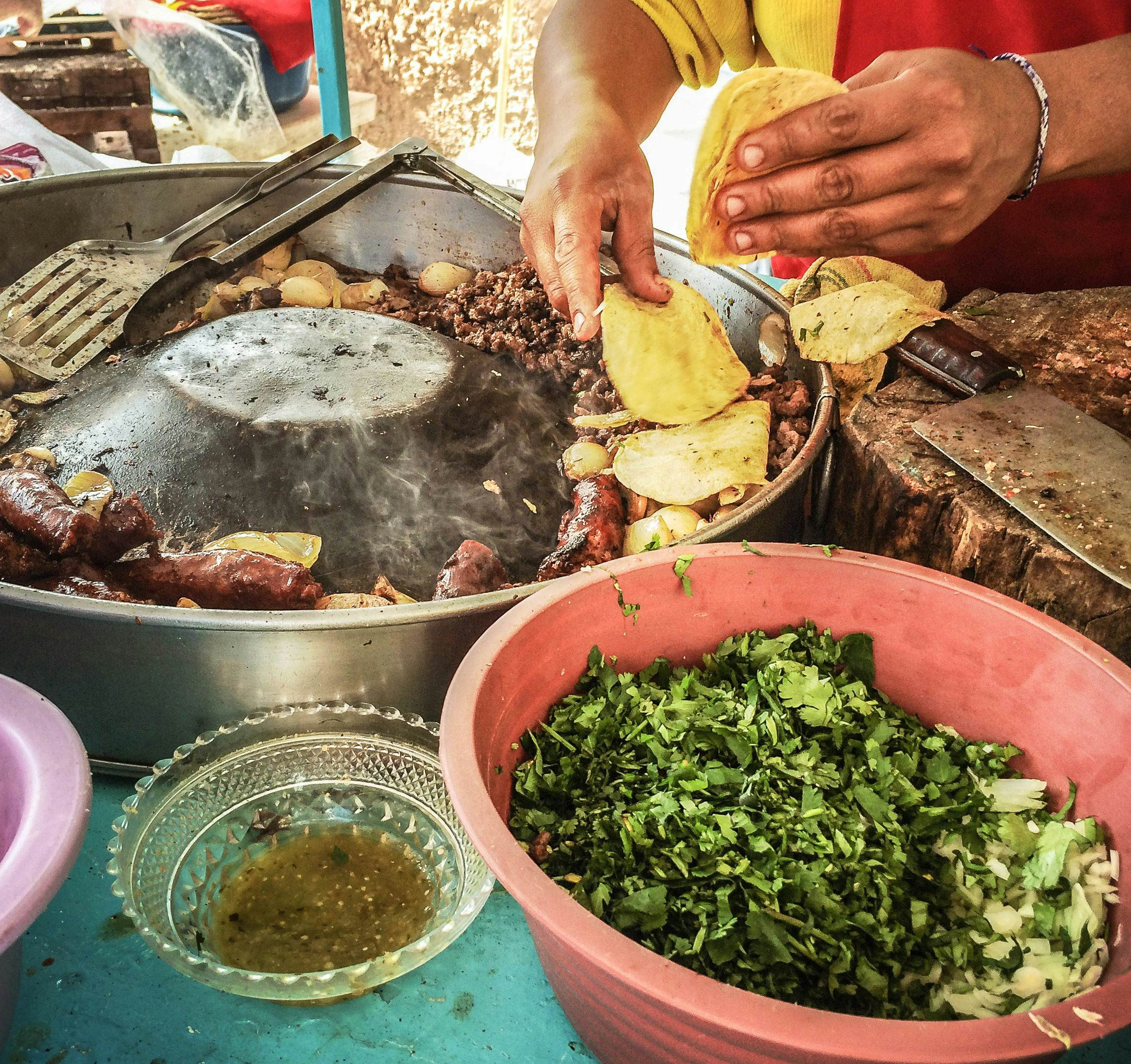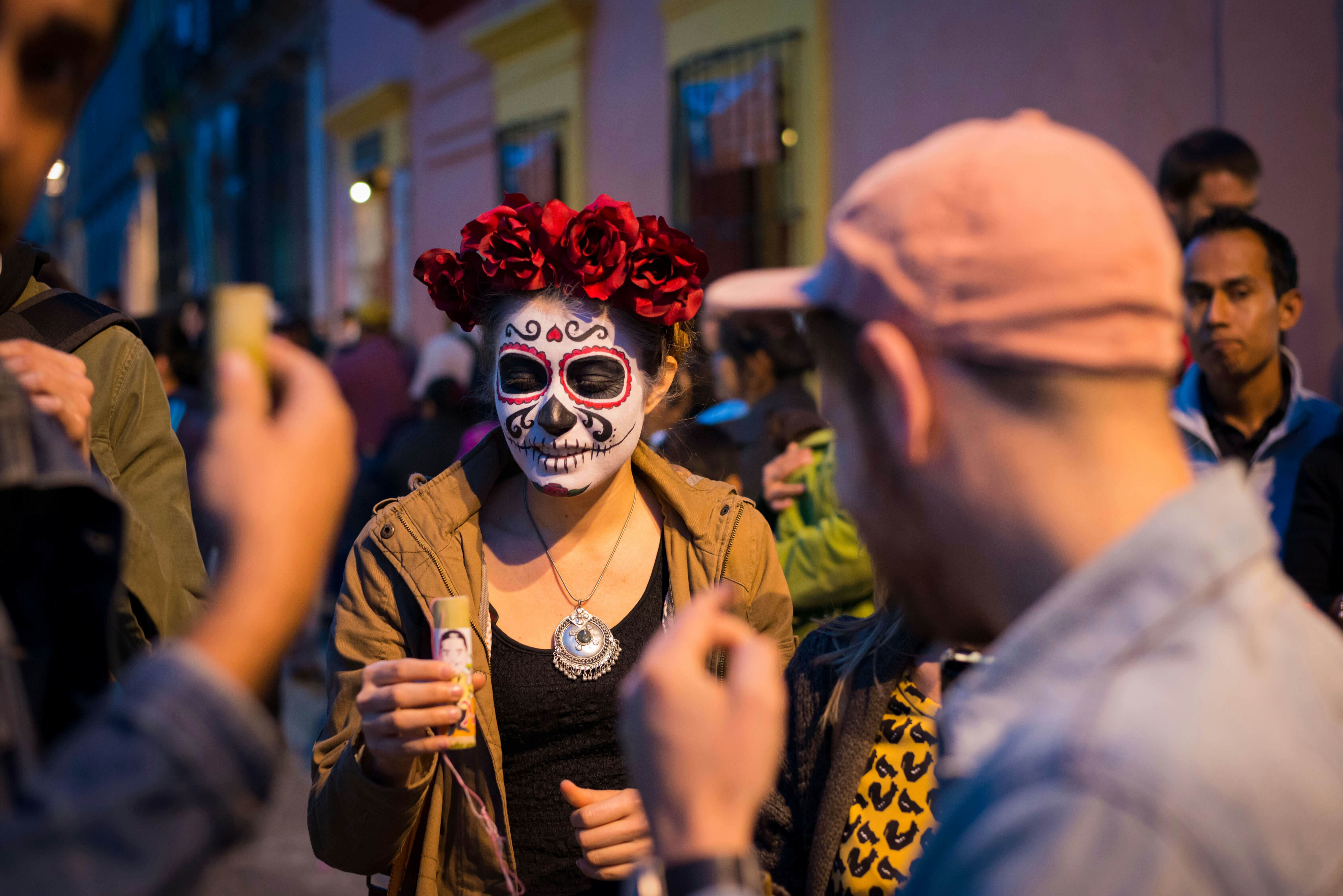Día de Muertos in Mexico, also known as the Day of the Dead, is a vibrant and meaningful celebration where LGBTQ+ individuals and allies honor deceased loved ones. At gaymexico.net, we’re excited to guide you through the festivities, highlighting how Mexican culture embraces both remembrance and celebration, offering a unique travel experience. Discover cultural insights and inclusive events in Mexico, ensuring an unforgettable experience.
Table of Contents
- What is Día de Muertos?
- When Is Día de Muertos Celebrated?
- How to Create an Ofrenda (Altar)?
- Visiting Cemeteries During Día de Muertos: What to Expect?
- Why are Marigolds Important During Día de Muertos?
- What Traditional Foods are Prepared for Día de Muertos?
- Why Do People Paint Their Faces as Skeletons?
- Where Can You Participate in Special Día de Muertos Events?
- What Are Some Common Misconceptions About Día de Muertos?
- How is Día de Muertos Celebrated Differently in Various Regions of Mexico?
- FAQ Section
1. What is Día de Muertos?
Día de Muertos, or Day of the Dead, is a profoundly meaningful Mexican holiday celebrated to honor deceased loved ones, emphasizing remembrance and celebration. This celebration is a cultural cornerstone in Mexico, blending indigenous Aztec and Toltec traditions with Catholic influences from Spanish colonization. Recognized by UNESCO for its cultural significance, Día de Muertos underscores the belief that the spirits of the departed return to visit their families. This celebration provides a poignant reminder of the cyclical nature of life and death, inviting families and communities to remember and celebrate the lives of those who have passed on.
Día de Muertos is more than just a remembrance; it’s a vibrant expression of Mexican identity, filled with joy, color, and deep emotional resonance. Families construct ofrendas, or altars, adorned with photographs, favorite foods, and cherished mementos of the deceased. Cemeteries are transformed into festive gathering places, illuminated by candlelight and filled with music, storytelling, and shared meals. This unique approach to honoring the dead embraces the idea that mourning and celebration can coexist, offering a powerful reminder of the enduring bonds of love and kinship.
 Pre-Day of the Dead Preparations. FG Trade Latin/Getty Images
Pre-Day of the Dead Preparations. FG Trade Latin/Getty Images
2. When Is Día de Muertos Celebrated?
Día de Muertos is celebrated primarily on November 1st and 2nd, with preparations often beginning in mid to late October. November 1st is dedicated to children who have passed away, known as Día de los Inocentes or Día de los Angelitos. This day focuses on celebrating the lives of these young ones with special offerings and decorations.
November 2nd is dedicated to adults who have died and is referred to as Día de los Muertos or Día de los Difuntos. This day involves visiting cemeteries, adorning graves with flowers and candles, and sharing stories and memories of the departed. The timing of these celebrations aligns with the Catholic holidays of All Saints’ Day and All Souls’ Day, reflecting the fusion of indigenous and religious traditions. This period is a time of reflection, remembrance, and joyous celebration, as families come together to honor their ancestors.
3. How to Create an Ofrenda (Altar)?
Creating an ofrenda, or altar, is a central part of Día de Muertos celebrations, serving as a heartfelt tribute to deceased loved ones. These altars are typically set up in homes and businesses, starting in mid-October. An ofrenda can range from a simple display to an elaborate multi-tiered arrangement, but all share common elements designed to honor and welcome the spirits of the departed.
Essential components of an ofrenda include:
- Photographs: Images of the deceased are placed prominently on the altar, serving as a focal point for remembrance.
- Food and Drink: The favorite foods and beverages of the departed are offered, enticing them to return and partake in the celebration.
- Personal Items: Small, cherished items such as toys, books, or articles of clothing that the deceased loved are included, adding a personal touch.
- Candles: Lit candles symbolize guidance and illumination for the spirits, helping them find their way home.
- Flowers: Marigolds, known as cempasúchil, are the quintessential Day of the Dead flower, believed to attract spirits with their vibrant color and fragrance.
- Religious Symbols: Crosses and images of saints are often included to honor the religious beliefs of the deceased.
- Papel Picado: Colorful, perforated paper banners add a festive touch to the altar, representing the fragility of life.
Setting up an ofrenda is a deeply personal and meaningful act, reflecting the love, respect, and remembrance that families hold for their departed loved ones.
4. Visiting Cemeteries During Día de Muertos: What to Expect?
Visiting cemeteries during Día de Muertos is a deeply moving and festive experience, reflecting the unique way Mexicans honor their deceased loved ones. Unlike somber visits to cemeteries in other cultures, Día de Muertos brings an atmosphere of celebration and remembrance. Families gather at the gravesites of their ancestors to clean and decorate them with vibrant flowers, candles, and cherished mementos.
The energy in the cemeteries is often lively and respectful, with families bringing folding chairs and blankets to settle in for the day or night. Food, drinks, and storytelling are integral parts of the experience, as families share memories and celebrate the lives of those who have passed on. Live music is also common, with musicians wandering through the cemeteries, serenading the gravesites with the favorite tunes of the deceased.
Visiting a cemetery during Día de Muertos offers a unique glimpse into Mexican culture, highlighting the community’s deep connection to their ancestors and their joyful approach to honoring death. It is a time of unity, remembrance, and celebration, reflecting the enduring bonds of family and kinship.
 Illuminated gravesites during Día de Muertos. Shutterstock
Illuminated gravesites during Día de Muertos. Shutterstock
5. Why are Marigolds Important During Día de Muertos?
Marigolds, known as cempasúchil in Mexico, hold a special significance during Día de Muertos, serving as the official flower of the dead. Native to central Mexico, these vibrant orange flowers have been used in Day of the Dead celebrations since ancient times. Their vivid hue and distinctive fragrance are believed to attract and guide the spirits of the deceased back to their homes.
During Día de Muertos, marigolds are prominently displayed on ofrendas and gravesites, transforming cemeteries into seas of orange. Petals are often strewn before altars in a nod to ancient beliefs, creating a pathway for the spirits to follow. The use of marigolds during Día de Muertos is a powerful symbol of remembrance and connection to the spirit world, reflecting the enduring traditions and cultural heritage of Mexico.
6. What Traditional Foods are Prepared for Día de Muertos?
Food is an integral part of Día de Muertos celebrations, with traditional dishes prepared to honor the deceased and entice them to return home. Ofrendas are adorned with the favorite foods of the departed, representing not only their personal preferences but also the diverse regional cuisines of Mexico.
Some of the most common and significant foods prepared for Día de Muertos include:
- Pan de Muerto (Bread of the Dead): This sweet, spongy bread is a staple of Día de Muertos, representing the cycle of life and death. It is typically decorated with bone-shaped designs and sprinkled with sugar.
- Mole Negro: A complex and flavorful sauce made with chili peppers, chocolate, spices, and nuts, often served with chicken or turkey.
- Pozole: A hearty stew made with hominy, meat, and a variety of toppings, such as shredded cabbage, radishes, and avocado.
- Calabaza en Tacha: Candied pumpkin cooked in sugar cane syrup, a sweet treat enjoyed during the celebration.
- Tamales: Corn dough pockets filled with meat, cheese, or vegetables, wrapped in corn husks or banana leaves and steamed.
These foods are not only offerings to the spirits but also a way for families to come together and share in the celebration of life and remembrance. The preparation and sharing of these traditional dishes reinforce the bonds of family and community, making Día de Muertos a truly special and meaningful occasion.
 Food for Day of the Dead. PamelaViola/Getty Images
Food for Day of the Dead. PamelaViola/Getty Images
7. Why Do People Paint Their Faces as Skeletons?
Skeleton imagery is a prevalent and iconic aspect of Día de Muertos celebrations, largely due to the influence of La Catrina. La Catrina is a high-society skeleton created in the early 1900s by satirical cartoonist José Guadalupe Posada. This figure embodies the idea that death spares no one, regardless of wealth or status.
The image of La Catrina gained further prominence through the art of Mexican muralist Diego Rivera and has since become a national symbol of Día de Muertos. Today, skeleton imagery is widely used in decorations, candy skulls, and papel picado banners. During parades and processions, many people paint their faces to resemble skulls and dress in colorful regional costumes or Victorian-era attire, paying homage to La Catrina.
Face painting as skeletons during Día de Muertos is a way to connect with the holiday’s themes of death and remembrance while celebrating life and Mexican culture. It is a visual representation of the belief that death is a natural part of the human experience and should be embraced rather than feared.
8. Where Can You Participate in Special Día de Muertos Events?
Día de Muertos is traditionally a family-oriented celebration, but in recent years, larger-scale festivities have emerged throughout Mexico. These events range from cemetery processions and city-wide parades to street fairs with food vendors and neon-lit rides. Some of the standout celebrations include:
- Mexico City’s Desfile de Alebrijes (Parade of Spirit Guides): This parade features fantastical creatures, elaborate floats, and thousands of participants dressed in skeleton costumes.
- Mixquic’s La Alumbrada (The Lighting): The streets are adorned with Day of the Dead murals, and the town goes dark except for the cemetery, where thousands of candles illuminate the gravesites.
- Janitzio Island in Michoacán: Thousands gather to watch the arrival of flower-covered, candlelit canoes, kicking off a nightlong vigil at the town cemetery.
- Oaxaca City’s Week of Festivities: This includes dance and music performances, graveyard tours, and a “best altar” competition.
- Mérida’s Paseo de las Ánimas (Procession of the Souls): More than 50,000 people participate, walking from the main cemetery to the town center, passing hundreds of candlelit ofrendas.
These special events offer visitors a unique opportunity to immerse themselves in the vibrant culture and traditions of Día de Muertos. Attending these celebrations can provide a deeper understanding of the holiday’s significance and a chance to connect with the local community.
 Day of the Dead Celebrations. Joel Carillet/Getty Images
Day of the Dead Celebrations. Joel Carillet/Getty Images
9. What Are Some Common Misconceptions About Día de Muertos?
Día de Muertos is often misunderstood and oversimplified, leading to several common misconceptions. One prevalent misconception is that it is a morbid or sad occasion. In reality, Día de Muertos is a celebration of life and remembrance, filled with joy, color, and deep emotional resonance. It is a time to honor and celebrate the lives of those who have passed on, rather than mourning their death.
Another misconception is that Día de Muertos is the “Mexican Halloween.” While both holidays share some similarities, such as the use of costumes and decorations, their origins and meanings are distinct. Halloween is rooted in Celtic traditions and focuses on warding off evil spirits, while Día de Muertos is a celebration of the lives of deceased loved ones.
Additionally, some people mistakenly believe that Día de Muertos is exclusively a religious holiday. While it does incorporate Catholic traditions, its roots lie in indigenous beliefs and practices that predate the arrival of the Spanish. Día de Muertos is a unique blend of cultural and religious influences, reflecting the rich heritage of Mexico.
10. How is Día de Muertos Celebrated Differently in Various Regions of Mexico?
Día de Muertos is celebrated throughout Mexico, but the specific traditions and customs can vary significantly from region to region. These regional variations reflect the diverse cultural and historical influences that have shaped the country.
In Oaxaca, for example, Día de Muertos is a week-long celebration that includes elaborate altar competitions, music and dance performances, and graveyard tours. The city is adorned with vibrant decorations, and families create intricate sand tapestries to honor their deceased loved ones.
In Michoacán, particularly on Janitzio Island, the celebration is centered around a nightlong vigil at the town cemetery. The arrival of flower-covered, candlelit canoes on Lake Pátzcuaro is a spectacular sight that draws thousands of visitors.
In Yucatán, the Paseo de las Ánimas (Procession of the Souls) is a major event, with thousands of people dressed in traditional Yucatecan clothing and skeleton face paint walking from the main cemetery to the town center.
These regional differences highlight the richness and diversity of Mexican culture, making Día de Muertos a truly unique and unforgettable experience.
FAQ Section
-
Is Día de Muertos a sad holiday?
No, Día de Muertos is a vibrant celebration of life and remembrance, filled with joy, color, and deep emotional resonance.
-
What is an ofrenda?
An ofrenda is an altar set up in homes and businesses to honor deceased loved ones, adorned with photographs, food, and cherished mementos.
-
Why are marigolds used during Día de Muertos?
Marigolds, known as cempasúchil, are believed to attract and guide the spirits of the deceased back to their homes with their vibrant color and fragrance.
-
What is pan de muerto?
Pan de muerto is a sweet, spongy bread that is a staple of Día de Muertos, representing the cycle of life and death.
-
Who is La Catrina?
La Catrina is a high-society skeleton created by José Guadalupe Posada, embodying the idea that death spares no one, regardless of wealth or status.
-
Can tourists participate in Día de Muertos celebrations?
Yes, tourists are welcome to participate in Día de Muertos celebrations, but it is important to be respectful of the local traditions and customs.
-
What should I wear to a Día de Muertos event?
Many people dress in colorful regional costumes or skeleton face paint, but it is also appropriate to wear respectful and comfortable clothing.
-
Is Día de Muertos the same as Halloween?
No, while both holidays share some similarities, their origins and meanings are distinct. Halloween is rooted in Celtic traditions and focuses on warding off evil spirits, while Día de Muertos is a celebration of the lives of deceased loved ones.
-
Are there LGBTQ+ specific celebrations during Día de Muertos in Mexico?
While Día de Muertos is a general celebration, many LGBTQ+ individuals and allies participate, honoring their loved ones within the broader cultural context. For LGBTQ+-friendly events and spaces, check out gaymexico.net for resources.
-
How can I learn more about LGBTQ+ travel in Mexico?
Visit gaymexico.net for comprehensive guides, tips, and information about LGBTQ+-friendly destinations, events, and resources in Mexico.
Ready to immerse yourself in the beauty and traditions of Día de Muertos? Explore gaymexico.net for more insights, travel tips, and LGBTQ+ friendly destinations in Mexico. Come and discover a world where remembrance meets celebration, and where everyone is welcome.
Address: 3255 Wilshire Blvd, Los Angeles, CA 90010, United States. Phone: +1 (213) 380-2177.
